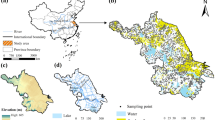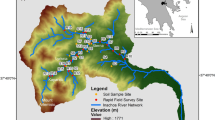Abstract
Soil erodibility (K) affects sediment delivery to streams and needs to be appropriately quantified and interpolated as a fundamental geographic variable for implementing suitable catchment management and conservation practices. The spatial distribution of K for erosion modelling at non-sampling grid locations has traditionally been estimated using interpolation algorithms such as kriging which do not adequately represent the uncertainty of estimates. These methods cause smoothing effects through overestimating the low values and underestimating the large values. In this study observed values were used to implement a sequential Gaussian simulation (SGS) procedure to evaluate the certainty of modelled data. Soil erodibility values were computed using 41 soil samples taken from the top 10 cm soil layer regularly distributed across four catchments, 367–770 ha in area, within Kangaroo River State forest, New South Wales (NSW). One hundred realisations were applied in the simulation process to provide spatial uncertainty and error estimates of soil erodibility. The results indicated that values simulated by the SGS algorithm produced similar K values for the neighbouring cells. At the pixel level, the SGS approach generated a reliable estimation of soil erodibility in most areas. Spatial variation of the K factor in this study was strongly related to soil landscape differences across the catchments; within catchments slope gradient did not have a substantial impact on the numerical values of the K factor using pixel-by-pixel comparisons of raster grid maps.









Similar content being viewed by others
References
Baskan O, Cebel H, Akgul S, Erpul G (2010) Conditional simulation of USLE/RUSLE soil erodibility factor by geostatistics in a Mediterranean catchment, Turkey. Environ Earth Sci 60:1179–1187
Berterretche M, Hudak AT, Cohen WB, Maiersperger TK, Gower ST, Dungan J (2005) Comparison of regression and geostatistical methods for mapping Leaf Area Index (LAI) with Landsat ETM+ data over a boreal forest. Remote Sens Environ 96:49–61
Bhattarai R, Dutta D (2007) Estimation of soil erosion and sediment yield using GIS at catchment scale. Water Resour Manage 21:1635–1647
Bhattarai R, Dutta D (2008) A comparative analysis of sediment yield simulation by empirical and process-oriented models in Thailand. Hydrol Sci J 53(6):1253–1269
Buttafuoco G, Conforti M, Aucelli PPC, Robustelli G, Scarciglia F (2011) Assessing spatial uncertainty in mapping soil erodibility factor using geostatistical stochastic simulation. Environ Earth Sci. doi:10.1007/s12665-011-1317-0
Deutsch C, Journel A (1998) GSLIB: geostatistical software library and user’s guide, vol 7, 2nd edn. Oxford University Press, New York
Di Stefano C, Ferro V (2002) Linking clay enrichment and sediment delivery processes. Biosyst Eng 81(4):465–479
Dragovich D, Morris R (2002) Sediment and organic matter transfer following bushfires in the Blue Mountains, Australia. In: Dyer FJ, Thoms MC, Olley JM (eds) The structure, function and management implications of fluvial sedimentary systems (Proc. Alice Springs Symp.). IAHS Publication No. 276:325–331
Forestry Commission of NSW (1989) Forest types in New South Wales, Research Note 17. Forestry Commission of NSW, Sydney
Gamma Design (2004) Geostatistics for the environmental sciences. Version 7.0. Plainwell
Gitas IZ, Douros K, Minakou1 C, Silleos GN, Karydas CG (2009) Multi-temporal soil erosion risk assessment. In: Chalkidiki N (ed) Using a modified USLE Raster model. EARSeL eProceedings 8(1):40–52
González-Hidalgo JC, de Luis M, Batalla RJ (2009) Effects of the largest daily events on total soil erosion by rainwater. An analysis of the USLE database. Earth Surf Proc Land 34:2070–2077
Goovaerts P (1999) Impact of the simulation algorithm, magnitude of ergodic fluctuations and number of realizations on the spaces of uncertainty of flow properties. Stoch Environ Res Risk Assess 13:161–182
Goovaerts P, Trinh HA, Demond A, Franzblau A, Garabrant D, Gillespie B (2008) Geostatistical modeling of the spatial distribution of soil dioxins in the vicinity of an incinerator. 1. Theory and application to Midland, Michigan. Environ Sci Technol 42:3648–3654
Inter-governmental Committee on Surveying and Mapping (ICSM) (1994) A new era for Australia. Information Circular, Inter-governmental Committee on Surveying and Mapping, Belconnen
Isbell RF (1996) The Australian Soil Classification. Australian soil and land survey handbook. CSIRO Publishing, Melbourne
Johnson DW, Curtis PS (2001) Effects of forest management on soil C and N storage: meta analysis. For Ecol Manage 2–3(140):227–238
Journel AG, Huijbregts CHJ (1978) Mining geostatistics. Academic Press, London, p 600
Juang KW, Chen YS, Lee DY (2004) Using sequential indicator simulation to assess the uncertainty of delineating heavy-metal contaminated soils. Environ Pollut 127:229–238
Karaburun A (2010) Estimation of C factor for soil erosion modeling using NDVI in Buyukcekmece watershed. Ozean J Appl Sci 3(1):77–85
Klute A, Dirksen C (1986) Hydraulic conductivity and diffusivity: laboratory methods. In: Klute A (ed) Methods of soil analysis. Part 1. 2nd edn. Agronomy monograph no. 9 ASA and SSSA, Madison, pp 687–734
Lu D, Li G, Valladares G, Batistella M (2004) Mapping soil erosion risk in Rondonia, Brazilian Amazonia: using RUSLE, remote sensing and GIS. Land Degrad Dev 15:499–512
Lunney D, Moon C, Matthews A, Turbill J (1999) Koala plan of management. NSW National Parks and Wildlife Service, Australia
Mati BM, Veihe A (2001) Application of the USLE in a Savannah environment: comparative experiences from East and West Africa. Singap J Trop Geogr 22(2):138–142
Milford HB (1996) Soil landscapes of the Dorrigo 1:100 000 sheet map. Dept of Land and Water Conservation, Sydney
Nelson DW, Sommers LE (1996) Total carbon, organic carbon, and organic matter. In: Methods of soil analysis, part 3. Chemical methods, vol 5. Soil Science Society of America, Madison, pp 961–1010
Parysow P, Wang G, Gertner G, Anderson AB (2003) Spatial uncertainty analysis for mapping soil erodibility based on joint sequential simulation. Catena 53:65–78
Remy N, Boucher A, Wu J (2009) Applied geostatistics with SGeMS: a user’s guide. Cambridge University Press, Cambridge
Renard KG, Foster GR, Weesies GA, McCool DK (1997) Predicting soil erosion by water: a guide to conservation planning with the Revised Universal Soil Loss Equation (RUSLE), vol 703. Agricultural Handbook, US Department of Agriculture, Washington, DC
Rosewell CJ (1993) SOILOSS: a program to assist in the selection of management practices to reduce erosion. Technical Handbook No. 11, 2nd edn. Soil Conservation Service of NSW, Sydney
Singer MJ, Walker PH (1983) Rainfall-runoff in soil erosion with simulated rainfall, overland flow and cover. Aust J Soil Res 21:109–122
SPSS Inc. (2010) Statistical package for the social sciences (SPSS) Version 19.0 for windows. SPSS Inc., Chicago
Todd MJ, Lowrance RR, Goovaerts P, Vellidis G, Pringle CM (2010) Geostatistical modeling of the spatial distribution of sediment oxygen demand within a Coastal Plain blackwater watershed. Geoderma 159:53–62
Wang G, Gertner G, Liu X, Anderson A (2001) Uncertainty assessment of soil erodibility factor for revised universal soil loss equation. Catena 46:1–14
Wang G, Gertner G, Singh V, Shinkareva S, Parysow P, Anderson A (2002) Spatial and temporal prediction and uncertainty of soil loss using the revised universal soil loss equation: a case study of the rainfall–runoff erosivity R factor. Ecol Model 153:143–155
Webb AA, Dragovich D, Jamshidi R (2012) Temporary increases in suspended sediment yields following selective eucalypt forest harvesting. For Ecol Manage 283:96–105. doi:10.1016/j.foreco.2012.07.017
Wischmeier WH, Smith DD (1978) Predicting rainfall-erosion losses from cropland east of the Rock Mountains—a guide to conservation planning. Agricultural Handbook No. 537. US Department of Agriculture, Washington, DC
Yang Q, Zhao Z-Y, Chow TL, Rees HW, Bourque CP-A, Meng F-R (2009) Using GIS and a digital elevation model to assess the effectiveness of variable grade flow diversion terraces in reducing soil erosion in northwestern New Brunswick, Canada. Hydrol Process 23:3271–3280
Acknowledgments
The first author is grateful to Forestry Corporation of NSW (formerly Forests NSW) for supplementary financial support, and to Dr. Lisa Turner, Mr. Brad Jarrett and Mr. Tom Savage for their assistance during field surveys and laboratory analyses.
Author information
Authors and Affiliations
Corresponding author
Rights and permissions
About this article
Cite this article
Jamshidi, R., Dragovich, D. & Webb, A.A. Catchment scale geostatistical simulation and uncertainty of soil erodibility using sequential Gaussian simulation. Environ Earth Sci 71, 4965–4976 (2014). https://doi.org/10.1007/s12665-013-2887-9
Received:
Accepted:
Published:
Issue Date:
DOI: https://doi.org/10.1007/s12665-013-2887-9




